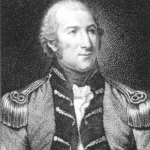The United Irishmen
In Brief:
A number of people across Ireland had been hugely impressed by the achievements of both the American and French Revolutions. Both had revolted against unfair systems of monarchy and attempted to replace them with the principles of fairness and equality. With the promise of French help to any nation that sought to create a republican system of government, some Irish people felt that now was the time to take action action against the unfair and oppressive British rule. Some of these men met in Belfast on 18 October 1791. Present at this meeting were:
- Theobald Wolfe Tone
- Henry Joy McCracken
- Samuel Nielson
- Thomas Russell
- William Sinclair
- Henry Haslett
- Gilbert McIlveen
- William Simms
- Robert Simms
- Thomas McCabe
- Thomas Pearce
These men swore ‘that I will use all my abilities and influence in the attainment of an impartial and adequate representation of the Irish people in parliament…..to forward a brotherhood of affection, an identity of interests, a communion of rights, and a union of power among Irishmen of all religious persuasions.”
________________________
___________________________________________________________________________
________________________________________________________________
United Irishmen
Origins
The immediate origins of the 1798 Rebellion in Ireland can be traced to the setting up of the Society of United Irishmen in Belfast in October 1791. Inspired by the French Revolution, and with great admiration for the new democracy of the United States, the United Irishmen were led by Theobald Wolfe Tone, Thomas Russell, Henry Joy McCracken and William Drennan. They came together to secure a reform of the Irish parliament; and they sought to achieve this goal by uniting Protestant, Catholic and Dissenter in Ireland into a single movement.
From the beginning, Dublin Castle, the seat of government in Ireland, viewed the new organisation with the gravest suspicion, and with the outbreak of war between Britain (and Ireland) and France in February 1793, suspicion hardened to naked hostility. The unabashed admiration of the United Irishmen for the French seemed akin to treason. The discovery of negotiations between certain United Irishmen, notably Theobald Wolfe Tone, and the French government confirmed suspicions and led to the suppression of the society in May 1794.
Driven underground, the Society re-constituted itself as a secret, oath-bound, organisation, dedicated to the pursuit of a republican form of government in a separate and independent Ireland. This was to be achieved primarily by direct French military intervention. The plan came closest to success following the arrival of a French invasion fleet, carrying some 14,000 soldiers, off the southern coast of Ireland in December 1796. Adverse weather conditions, however, prevented the French from landing, and the fleet was forced to make its way back to France. From this date on, Dublin Castle stepped up its war against the United Irishmen, infiltrating their ranks with spies and informers, invoking draconian legislation against subversives, turning a blind eye to military excesses, and to those of the resolutely loyalist Orange Order, and building up its defence forces lest the French should return in strength.
By the spring of 1798, it appeared that Dublin Castle had been successful in its determined efforts to destroy the Society’s capacity for insurrection: many of its leaders were in prison, its organisation was in disarray, and there seemed no possibility of French assistance. Despite these difficulties, on the night of the 23rd/24th May, as planned, the mail coaches leaving Dublin were seized – as a signal to those United Irishmen outside the capital that the time of the uprising had arrived.
However, as a result of the failure of Dublin to rise, the Rebellion when it came was distinguished everywhere by a lack of concert and by a lack of focus. The uprisings outside the capital had been intended by the United Irishmen as supporting acts – sideshows – to the main event in Dublin, but as Dublin did not perform as planned, rebels in outlying areas now found themselves promoted to centre-stage. In the lack of co-ordination between the rebel theatres of war lay the salvation of Dublin Castle and British rule in Ireland.
(Thomas Bartlett, Professor of Modern Irish History, UCD )
___________________________________________________________________________________________________________
[youtube]http://www.youtube.com/watch?v=9HCHrUZiP9Y[/youtube]
___________________________________________________________________________________________________________
History@Banagher College, Coláiste na Sionna.
The URI to TrackBack this entry is: http://teachnet.eu/tobrien/about/revolutions/revolution-in-ireland/the-united-irishmen/trackback/
One Comment Leave a comment.
Leave a Comment
You must be logged in to post a comment.




Very enjoyed this! Well done!